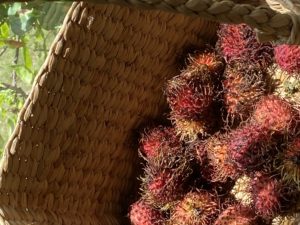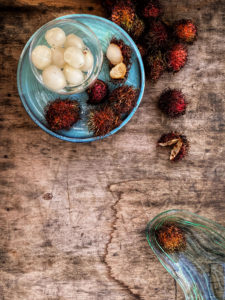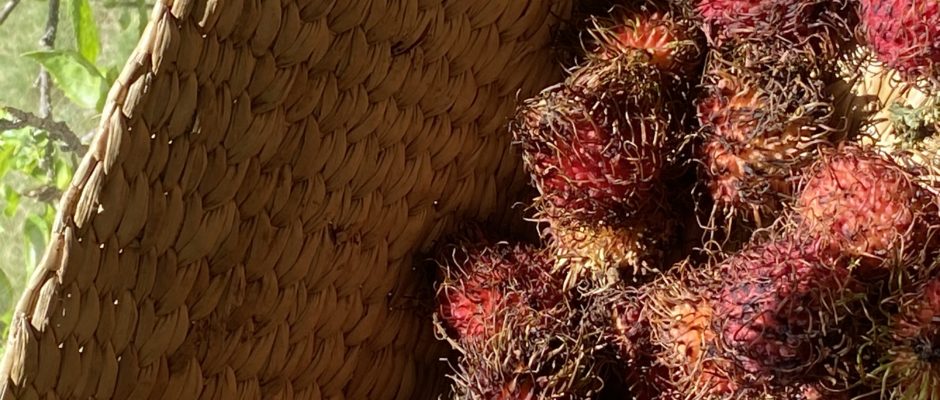Simplicity Coimbatore, Rambutan
Some months ago, before the initial lockdown, a friend had sent some wonderful produce from her farm. Among the lot were some fresh rambutan fruit. We ate a few and kept the rest aside and forgot about it for a couple of days by which time it had over ripened and changed colour.
Since it was organically grown fruit, we took them to the farm to leave the seeds out to dry in the sun before planting. When I took the fruit out of the basket and scooped them up in my palm to show the farmers, the one closest to me took a step back almost as if I was holding something dangerous!

At first, I was rather taken aback at his reaction. Once I got over my astonishment, I realised that he was just staring transfixed at the fruit. He was very hesitant to take it from me as if it would bite him or something. Silly me, didn’t realise how people can react when seeing an exotic (strange) fruit for the first time!
In all honesty the rambutan with its spiky coat does tend to look a bit wild! The name ‘Rambutan’ actually comes from the Malay word for ‘hair’ but I refrained from sharing that information with him!
I explained to him that it is a fruit which is very popular in other Asian countries. He seemed to relax a bit and smiled saying he had never seen anything like it! Since it is a tropical plant, I told him that we should try and grow it at the farm. Still not convinced, he asked if anyone here would eat it. I am not sure if it was his hesitation and that maybe he wasn’t so keen or never really bothered looking after a ‘strange’ species, but it finally never took root.
This week, one of the local organic food stores in Coimbatore (Wild Earth Foods), announced the arrival of rambutan fruits from Tenkasi. Naturally, we couldn’t wait to buy some.
The inside of the fruit has the taste and texture similar to that of the lychee fruit and is in fact from the same family. The pale translucent white pulp has a slippery but firm texture and sweet,slightly acidic taste. The rambutan fruit has its origins in Indonesia, Malaysia and Cambodia where it is enjoyed as a seasonal fruit and also used to infuse alcoholic and non-alcoholic drinks. Most often it is eaten raw. The skin while inedible apparently contains a whole range of minerals and compounds which accounts for its bright colour.(great for the compost bin)
History of food talks about Arab traders who took the Rambutan along with their travels across the Indian ocean. Kerala is the first state in India where it came to be cultivated in the 19th century. It is now found in places on the African continent, Philippines and in the islands of Trinidad and Tobago, to name a few. A tropical climate is what these trees thrive in. They fruit twice a year between the end of June to August and after December.

Eating about 5-6 fruits is said to provide the daily required dosage of Vitamin C. The Rambutan fruit is also rich in copper and manganese and as is the case with most fresh produce, beneficial for health when eaten during season. It is also a great source of fibre and adds adequate roughage to aid digestion.
Did you know that the Rambutan has both male as well as female trees? This is the reason why the blossoms on this tree are so highly fragrant (to attract the buzzers) . Pollination from bees, ants, butterflies and wasps is crucial to the formation of fruit on the female tree. The flowers on the male tree are said to be more aromatic than the ones on the female tree. Ant activity is higher with regard to rambutan pollination. We normally assume that the winged insects are responsible for pollination but research suggests that isn’t the case here.
The fruit hang in clusters, they are a bright green at first before maturing to a deep pink with an orange tinge. The seed is said to be poisonous but there is a technique for extracting oils which are then used in the cosmetic industry. The fruit is highly perishable a few days after picking. The pulp turns sour when the outer coat darkens and it must be discarded.
Malaysian cuisine is well known for its delicious curries containing coconut milk, lemon grass, ripe chillies, ginger and so many other heavenly scented spices. Just like how we use raisins to add that sweet burst in a savoury rice dish or pomegranate arils in a pachadi, chefs in Malaysia have attempted to use the rambutan fruit to add a different dimension in flavour to a spicy chicken curry. It actually sounds really interesting.
Recipe development is all about experimenting with fresh produce which is available to us. With my new lot of rambutan fruit from the beautiful district (Tenkasi) which is famous for its temples, I am hoping to do a few kitchen experimentations of my own. This time I am not even going to attempt asking our farmer to help with growing the saplings from seed, no need to add further stress than what COVID 19 is causing! I am happy that the grocers here are making an effort to make that connection from farm to table.
Hope this article has helped the first time rambutan tasters to not be afraid in trying this fruit. It is easy to open as well. The skin is soft. So, just hold on to one end of the fruit, press down in the middle and peel the skin away with the tips of the fingers. It doesn’t poke or give any discomfort. Oh and I forgot to mention one thing… It’s delicious!


No comments yet.